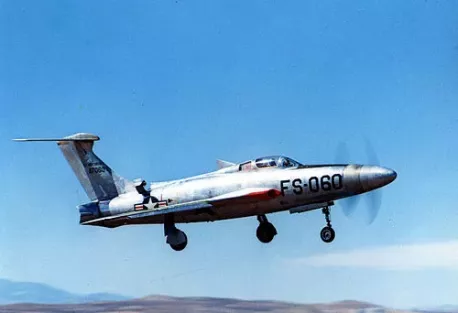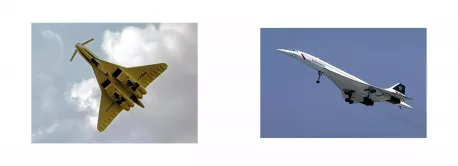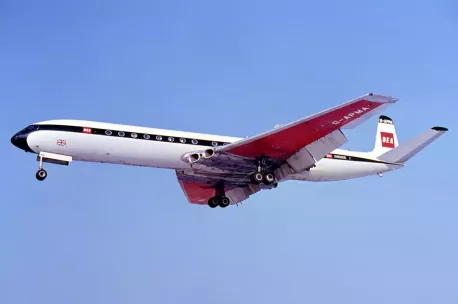Results: Even if a person has a fear of flying, they can still be fascinated about flying and have an interest in flying machines. This survey is about planes you might not want to fly on, even if you like flying.
Published on 07/12/2025
Before I retired, I used to take one or to flights every month for business reasons. I have flown on most of the common types of plane produced from the 1960s to the 2010. There were some types I never flew on however and am glad I didn't have to. There are also planes of the military kind I would have wanted to avoid if I had been in the armed forces. Here are some examples of planes that were best avoided.

QUESTIONS
GO to COMMENTS
Comments
1.
1.
In the early days of jet engines in the 1950s, it took a long runway to get a jet plane off the ground. Designers thought that, if they attached a propeller to a jet turbine they could solve this problem. They produced a plane that earned the nickname "The Thunderscreech" that solved the take off problem while creating a few new problems they hadn't anticipated. Here are some facts about the plane that might be interesting. Are they?

The initial inception came from a U.S. Navy requirement for a carrier fighter not requiring catapult assistance. Powered by a turbine engine that was mated to a supersonic propeller, the XF-84H had the potential of setting the unofficial air speed record for propeller-driven aircraft. It even had the potential to exceed the speed of sound - the only propeller plane capable of doing this.
26%
539 votes
First flown on July 22, 1955, its impracticality was soon discovered. It was unsuited to combat due to the engine's 30-minute warm-up time, and vibration caused by the 12-foot diameter propeller. The tips of the propeller exceeded the speed of sound creating a nonstop sonic boom. One of the test pilots assigned to the program, flew the aircraft once and refused to ever fly it again.
28%
592 votes
The constant noise also severely disrupted operations in the Edwards AFB control tower by risking vibration damage to sensitive components and forcing air traffic personnel to communicate with the crew by light signals. Eventually the plane had to be towed to the desert before starting up the engine.
25%
519 votes
Not Interested.
49%
1025 votes
The plane was the loudest aircraft ever built. On engine start up, it could be heard 25 miles (40 km) away. The shock wave was powerful enough to knock a man down. The aircraft was notorious for inducing severe nausea and headaches among ground crews. One engineer suffered a seizure after close range exposure to the shock waves emanating from a powered-up Thunderscreech.
27%
558 votes
Other (please specify)
1%
20 votes
| Other Answers | Percentage | Votes |
|---|---|---|
| 0.54% | 12 | |
| NA | 0.09% | 2 |
| not aware | 0.04% | 1 |
| I don't know anything about this except planes fly. All of these facts seem interesting to some point. | 0.04% | 1 |
| Don't know | 0.04% | 1 |
| interesting | 0.04% | 1 |
| None are interesting. Improving help to a safer plane. Hopefully. | 0.04% | 1 |
| None | 0.04% | 1 |
2.
2.
During the cold war, Russian leader Khrushchev was red faced about the plane he flew in for a summit meeting with Eisenhower. Khrushchev wanted a more impressive aircraft for international travels. The only Russian plane big enough was a Tupolev Tu-95 military bomber converted into the passenger variant, the Tu-114. The plane was big enough to compete with the Lockheed Constellations Eisenhower had and the interior looked opulent enough. Appearances were deceiving however. The Russian plane is on the left (of course). Would Ike have accepted a plane with some of these Tu-114 features?

The Tu-116, being derived from the military Tu- 95, had the same four turboprop engines driving two sets of propellers rotating in opposite directions. This design, while powerful, created a significant amount of noise and vibration. The tips of the propellers traveled faster than Mach 1, creating a sonic boom.
17%
350 votes
The Tu-95 is still in service as a bomber and is as loud as ever. So much so that NATO planes flying beside it on reconnaissance missions can hear the noise of the Russian plane above the noise of their own planes. The passenger compartment of the Tu-116 and its Tu-114 derivative would have been extremely loud. No wonder Khrushchev was always in a bad mood.
21%
444 votes
The Tu-114 had four sleeping compartments and a "restaurant" cabin in the midsection of the aircraft — the loudest section on the aircraft. VIPs like Nikita Khrushchev and his wife traveled in the sleeping compartments. I doubt if they slept much. When they arrived at Andrews AFB, the ground crew found the aircraft was so large and tall, they had no steps high enough to reach the hatch. Khrushchev and his party had to use the aircraft's emergency escape ladder.
20%
414 votes
The Russians did their best to compete with the USA but failed when it came to VIP transport. By 1959 Air Force One was now a Boeing 707, the first jet to be used. It was customized with a presidential stateroom, conference room, and communication equipment, effectively making it a "flying Oval Office." This plane remained in service until 1996.
20%
418 votes
Other (please specify)
1%
15 votes
Not Applicable
55%
1159 votes
| Other Answers | Percentage | Votes |
|---|---|---|
| 0.67% | 11 | |
| The 707 was the only one worth flying on. I liked Ike | 0.06% | 1 |
| I don't know anything about this except planes fly. All of these facts seem interesting to some point. | 0.06% | 1 |
| Don't know | 0.06% | 1 |
| interesting | 0.06% | 1 |
3.
3.
The Concorde was the world's first successful supersonic, passenger-carrying airplane, designed and built through the combined efforts of aircraft manufacturers in Great Britain and France. It could carry up to 128 passengers at a cruising speed of more than twice the speed of sound and fly from London to New York in under three and a half hours. Not to be outdone, the Russians developed their own "Concordski," the nickname given to the Tupolev Tu-144, due to its resemblance to the Concorde. While the Tu-144 flew first, it was a commercial failure, with a short and troubled history. Here are some facts about the "Concordski." Which would have made you say "Nyet" to a trip on this plane?

The Tu-144 had a delta wing, a downward-sloping nose, and canards (mini wings beside the nose), was larger and potentially faster, with a maximum speed of Mach 2.2 compared to Concorde's Mach 2.04. But it had to use afterburners (injecting fuel into the exhaust gases, causing further combustion for a boost in power) to achieve this speed. This reduced its range significantly eliminating many desirable routes.
22%
469 votes
The Tu-144 was notorious for its lack of insulation, causing significant vibration and noise in the passenger compartment. Concorde's high cruising altitude of 56,000 feet meant passengers received twice the radiation as those on a conventional flight. but due to the reduced flight time, the overall dose would be less. Unusual solar activity from sun spots might lead to an increase in incident radiation. The lack of insulation on the Tu-144 meant passengers had higher exposure to radiation.
28%
589 votes
Given the vast size of the Soviet Union, supersonic travel was economically feasible, while Concorde was controversial in the west due to noise and environmental pollution concerns. The rush to get Tu-144 airborne to beat the west exacted a heavy penalty later. Concorde's first flight was scheduled for February 1968, but was pushed back several times until March 1969 to iron out problems and test components more thoroughly. The 1963 Russian government said the Tu-144 would fly in 1968; it first flew on 31 December 1968 to fulfill these goals set five years earlier. Corners had been cut however leading to the fatal in-air breakup of the aircraft at the 1973 Paris Air Show.
26%
545 votes
Other (please specify)
1%
14 votes
Not Applicable
53%
1116 votes
| Other Answers | Percentage | Votes |
|---|---|---|
| 0.62% | 10 | |
| I don't know anything about this except planes fly. All of these facts seem interesting to some point. | 0.06% | 1 |
| It's a mofified Russian tractor | 0.06% | 1 |
| Don't know | 0.06% | 1 |
| All of the above | 0.06% | 1 |
4.
4.
Sometimes it doesn't pay to be first. Such was the case with the British de Havilland Comet, the world's first commercial jet airliner. Even today it looks advanced yet it first flew in 1949. It featured an aerodynamically clean design with four engines buried in the wing , a pressurized cabin, and large windows. For the era, it offered a relatively quiet, comfortable passenger cabin and was commercially promising at its debut in 1952. It was a quantum leap ahead of the propeller driven planes of the time. It was also ahead of the technology that would have detected its flaws. Would you have flown in one, once these issues were discovered and corrected? (I would but many wouldn't).

Within a year of the airliner's entry into service, three Comets were lost in highly publicized accidents after suffering catastrophic mishaps mid-flight. Two of these were found to be caused by structural failure resulting from metal fatigue in the air-frame, a phenomenon not fully understood at the time.
20%
430 votes
Dangerous stress concentrations around square cut-outs for the ADF (automatic direction finder) antennas were ultimately identified. This is why windows in the passenger compartments of planes and the corners of doors are now oval or curved in shape. Rival manufacturers heeded the lessons learned from the Comet when developing their own aircraft.
22%
466 votes
Although sales never fully recovered, the redesigned Comet 4 remained in commercial service until 1981. The plane was also adapted for a variety of military roles with the last Comet 4, used as a research platform, making its final flight in 1997. The most extensive modification resulted in a specialised maritime patrol derivative, the Hawker Siddeley Nimrod, which remained in service with the Royal Air Force until 2011, over 60 years after the Comet's first flight.
20%
421 votes
Other (please specify)
1%
18 votes
Not Applicable
58%
1225 votes
| Other Answers | Percentage | Votes |
|---|---|---|
| 0.90% | 12 | |
| I actually flew in Comets a number of time from England to Italy and back | 0.07% | 1 |
| I don't know anything about this except planes fly. All of these facts seem interesting to some point. | 0.07% | 1 |
| Don't know | 0.07% | 1 |
| no | 0.07% | 1 |
| let me stay on the ground. | 0.07% | 1 |
| No way. It's already hard for me to fly w/o help from meds from my doctor. | 0.07% | 1 |
COMMENTS


